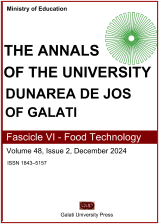Exploring the nutritional benefits of acorns: phytochemical profiles and biological activity
Abstract
Acorn, the fruit of Quercus species, is an edible nut with a long history in human diet and food resources. The study aimed to investigate the nutritional profiles of kernels and pericarps of acorns from Q. castaneifolia (Qc) and Q. brantii (Qb). Analysis of the Qc kernel revealed a high starch content (18.7±1.5%) and a lipid fraction rich in oleic acid (42.0%) and linoleic acid (34.1%). The Qb acorns exhibited a high quantity of total phenols (386.7 mg g−1 as gallic acid equivalent) and protein (1.30±0.19 mg g–1). Phytochemical analysis of the pericarp from Qc revealed a great flavonoid content (146.4 mg g−1 as catechin equivalent), contributing to its excellent antioxidant activity, as demonstrated by ABTS assays. The essential oil of the kernels from both acorn species contained α-pinene, heptanal, β-myrcene, limonene, methyl hexadecanoate, 2,5-Bis(1,1-dimethylethyl) phenol, 2,6-dimethyl naphthalene, and n-nonanal. The extract of Qc acorns exhibited inhibitory effects on the growth of S. aureus, S. epidermidis, P. aeruginosa, and E. coli as common pathogenic bacteria. With its rich compositional profiles and potent antioxidant and antimicrobial properties, acorn shows great promise in nutraceutical and nutritional benefits.


